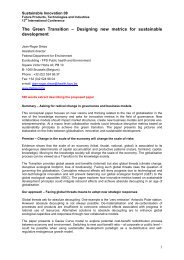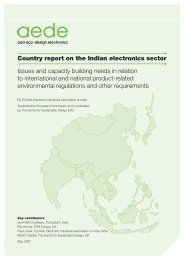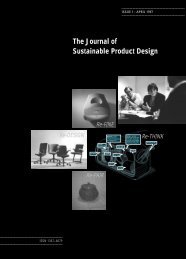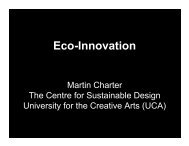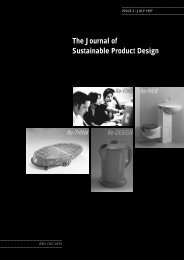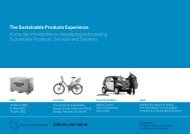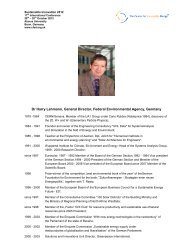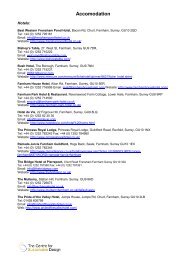acrobat JSPD 8 - The Centre for Sustainable Design
acrobat JSPD 8 - The Centre for Sustainable Design
acrobat JSPD 8 - The Centre for Sustainable Design
You also want an ePaper? Increase the reach of your titles
YUMPU automatically turns print PDFs into web optimized ePapers that Google loves.
process! Even though it is<br />
clearly their customers<br />
requirements and products<br />
and services<br />
that are central to the focus<br />
of business strategists.<br />
Without ‘Customers’, the<br />
findings of stakeholder<br />
dialogues, no matter how<br />
interesting, are of minimal<br />
strategic focus to the rest of<br />
the organisation. As the quote<br />
from a Tomorrow Magazine<br />
article (Frankel, 1998) on city<br />
analysts stated, a key strategy<br />
is to:<br />
‘increase demand-side pressure.<br />
When the world markets start to<br />
demanding environmentally superior<br />
per<strong>for</strong>mance, the investment<br />
community will take notice’_.<br />
Customers – the<br />
value strategy<br />
<strong>The</strong> authors contend that<br />
while the strategies<br />
mentioned in the introduction<br />
‘add value’ to the business<br />
through cost reduction<br />
and enhanced corporate<br />
image, in terms of core business<br />
activity the value is<br />
marginal. However add to<br />
these activities a strong<br />
customer, market focus and<br />
environment teams will be<br />
in a position of power.<br />
Customer focus –<br />
environment blind spot<br />
Environment teams are used<br />
to going to every stakeholder<br />
group to seek support except<br />
customers. Indeed, not all<br />
environment teams even<br />
identify customers as relevant<br />
stakeholders in consultation<br />
processes. For example in<br />
‘Bulldozing the Green Wall’<br />
_stakeholders are identified as<br />
‘local community members,<br />
the media, financial markets,<br />
investors and employees’.<br />
Not a customer in sight! <strong>The</strong><br />
arguments <strong>for</strong> not including<br />
customers are usually –<br />
customers don’t understand<br />
the issues, customers cannot<br />
be expected to know our<br />
business, its too technical,<br />
customers are only interested<br />
in price and always – they<br />
don’t care. <strong>The</strong> authors’ experience<br />
is that such an attitude<br />
will not enable the environment<br />
team to be a success in<br />
influencing the business.<br />
Some of the reasons why<br />
reluctance to engage<br />
customers has developed are<br />
outlined below:<br />
· early environmental<br />
pressure was focused on<br />
manufacturing organisations<br />
from NGOs and not directly<br />
from customers<br />
· long distribution chains <strong>for</strong><br />
goods and services place<br />
many organisations at a<br />
distance from their end<br />
user customers<br />
· many direct customer<br />
contacts on environmental<br />
issues are perceived as<br />
negative ie. customer<br />
complaints or queries<br />
· environmental teams<br />
may perceive talking to<br />
customers will only stir up<br />
more complaints, misunderstandings<br />
or expectations<br />
which cannot be fulfilled<br />
· environmental people tend<br />
to be technical, scientific by<br />
training rather than communication,<br />
marketing focused<br />
· sales and marketing people<br />
rarely move into environmental<br />
roles<br />
· failure of ‘green’ products<br />
in the market place.<br />
<strong>The</strong> question then is how can<br />
we overcome barriers such as<br />
these to become market<br />
focused?<br />
Market analysis –<br />
the business case<br />
<strong>The</strong> discussion so far has<br />
demonstrated that environment<br />
teams must be market<br />
and customer focused if they<br />
are to be of strategic importance<br />
to the business. Being<br />
market focused means establishing<br />
environment as a core<br />
value with product, procurement<br />
and marketing managers<br />
of your key customers. To<br />
achieve this, the authors<br />
recommend a combination<br />
of market analysis and direct<br />
customer contact (through<br />
carefully managed workshops/<br />
focus groups).<br />
<strong>The</strong> ultimate objective is to<br />
have your key customer’s<br />
value and become engaged in<br />
the process of environmental<br />
improvement of your products<br />
and services. In order to<br />
get access to your customers<br />
to begin the process of<br />
engagement it is advisable to<br />
undertake an integrated environmental<br />
market analysis.<br />
This will provide a clear view<br />
of environmental market<br />
trends, risks and opportunities<br />
and provide knowledge on<br />
which customers to start with<br />
and how.<br />
<strong>The</strong> market analysis should<br />
include at a minimum:<br />
JANUARY 1999 · THE JOURNAL OF SUSTAINABLE PRODUCT DESIGN<br />
INNOVATION<br />
53



